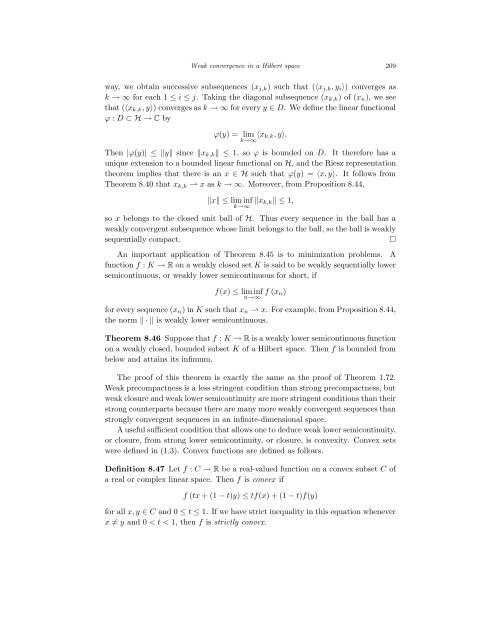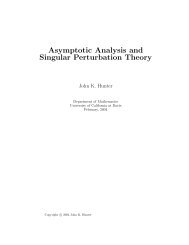Bounded Linear Operators on a Hilbert Space
Bounded Linear Operators on a Hilbert Space
Bounded Linear Operators on a Hilbert Space
Create successful ePaper yourself
Turn your PDF publications into a flip-book with our unique Google optimized e-Paper software.
Weak c<strong>on</strong>vergence in a <strong>Hilbert</strong> space 209<br />
way, we obtain successive subsequences (xj,k) such that (〈xj,k, yi〉) c<strong>on</strong>verges as<br />
k → ∞ for each 1 ≤ i ≤ j. Taking the diag<strong>on</strong>al subsequence (xk,k) of (xn), we see<br />
that (〈xk,k, y〉) c<strong>on</strong>verges as k → ∞ for every y ∈ D. We define the linear functi<strong>on</strong>al<br />
ϕ : D ⊂ H → C by<br />
ϕ(y) = lim<br />
k→∞ 〈xk,k, y〉.<br />
Then |ϕ(y)| ≤ y since xk,k ≤ 1, so ϕ is bounded <strong>on</strong> D. It therefore has a<br />
unique extensi<strong>on</strong> to a bounded linear functi<strong>on</strong>al <strong>on</strong> H, and the Riesz representati<strong>on</strong><br />
theorem implies that there is an x ∈ H such that ϕ(y) = 〈x, y〉. It follows from<br />
Theorem 8.40 that xk,k ⇀ x as k → ∞. Moreover, from Propositi<strong>on</strong> 8.44,<br />
x ≤ lim inf<br />
k→∞ xk,k ≤ 1,<br />
so x bel<strong>on</strong>gs to the closed unit ball of H. Thus every sequence in the ball has a<br />
weakly c<strong>on</strong>vergent subsequence whose limit bel<strong>on</strong>gs to the ball, so the ball is weakly<br />
sequentially compact. <br />
An important applicati<strong>on</strong> of Theorem 8.45 is to minimizati<strong>on</strong> problems. A<br />
functi<strong>on</strong> f : K → R <strong>on</strong> a weakly closed set K is said to be weakly sequentially lower<br />
semic<strong>on</strong>tinuous, or weakly lower semic<strong>on</strong>tinuous for short, if<br />
f(x) ≤ lim inf<br />
n→∞<br />
f (xn)<br />
for every sequence (xn) in K such that xn ⇀ x. For example, from Propositi<strong>on</strong> 8.44,<br />
the norm · is weakly lower semic<strong>on</strong>tinuous.<br />
Theorem 8.46 Suppose that f : K → R is a weakly lower semic<strong>on</strong>tinuous functi<strong>on</strong><br />
<strong>on</strong> a weakly closed, bounded subset K of a <strong>Hilbert</strong> space. Then f is bounded from<br />
below and attains its infimum.<br />
The proof of this theorem is exactly the same as the proof of Theorem 1.72.<br />
Weak precompactness is a less stringent c<strong>on</strong>diti<strong>on</strong> than str<strong>on</strong>g precompactness, but<br />
weak closure and weak lower semic<strong>on</strong>tinuity are more stringent c<strong>on</strong>diti<strong>on</strong>s than their<br />
str<strong>on</strong>g counterparts because there are many more weakly c<strong>on</strong>vergent sequences than<br />
str<strong>on</strong>gly c<strong>on</strong>vergent sequences in an infinite-dimensi<strong>on</strong>al space.<br />
A useful sufficient c<strong>on</strong>diti<strong>on</strong> that allows <strong>on</strong>e to deduce weak lower semic<strong>on</strong>tinuity,<br />
or closure, from str<strong>on</strong>g lower semic<strong>on</strong>tinuity, or closure, is c<strong>on</strong>vexity. C<strong>on</strong>vex sets<br />
were defined in (1.3). C<strong>on</strong>vex functi<strong>on</strong>s are defined as follows.<br />
Definiti<strong>on</strong> 8.47 Let f : C → R be a real-valued functi<strong>on</strong> <strong>on</strong> a c<strong>on</strong>vex subset C of<br />
a real or complex linear space. Then f is c<strong>on</strong>vex if<br />
f (tx + (1 − t)y) ≤ tf(x) + (1 − t)f(y)<br />
for all x, y ∈ C and 0 ≤ t ≤ 1. If we have strict inequality in this equati<strong>on</strong> whenever<br />
x = y and 0 < t < 1, then f is strictly c<strong>on</strong>vex.
















